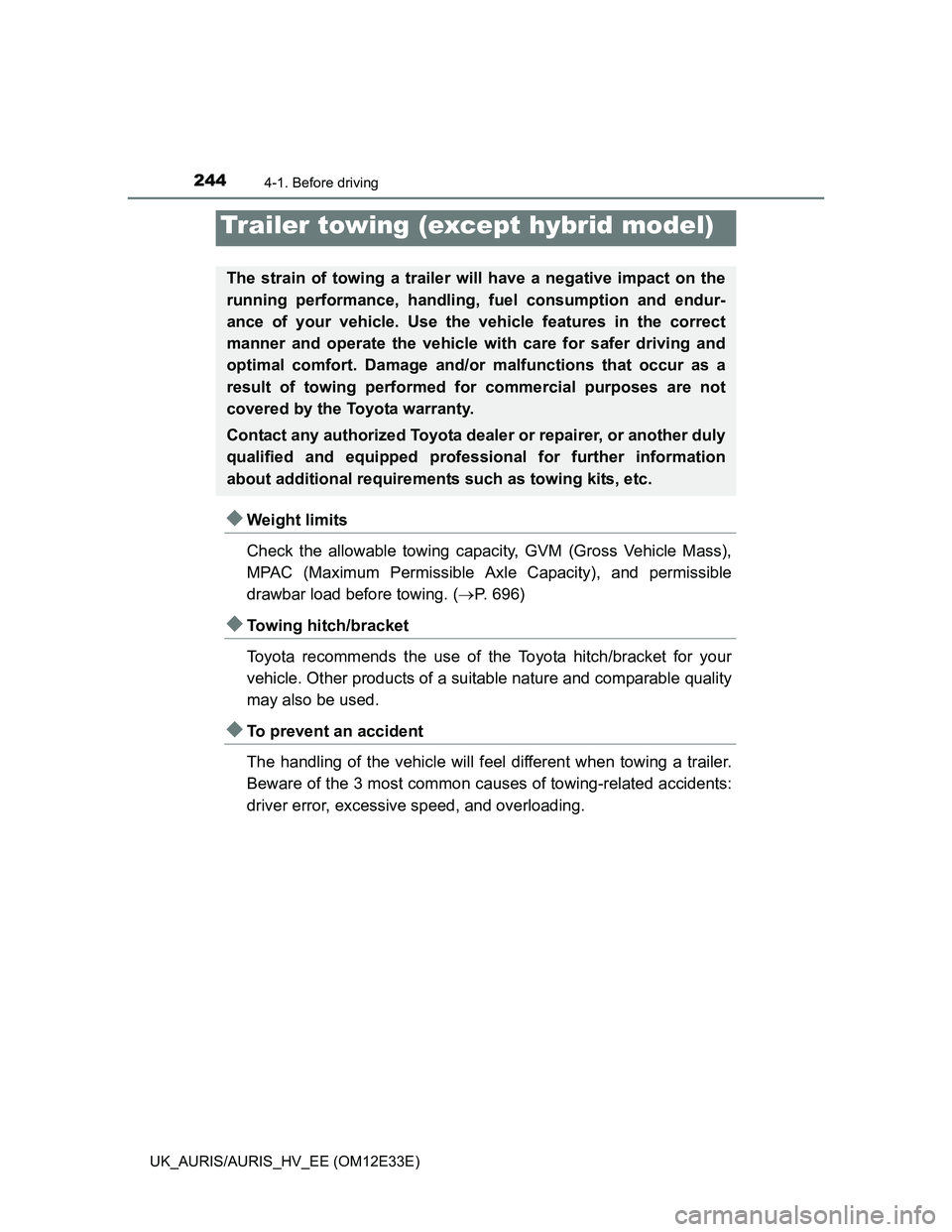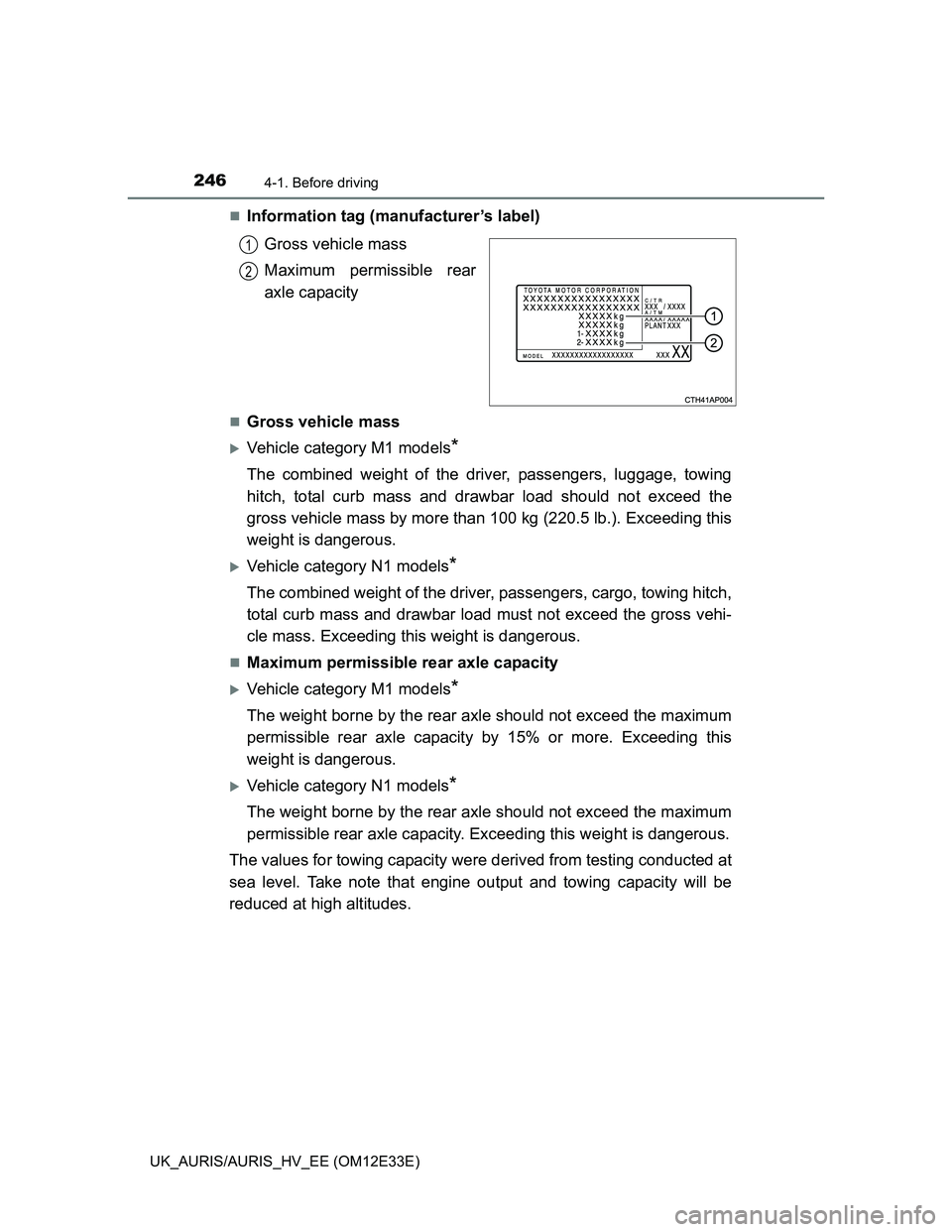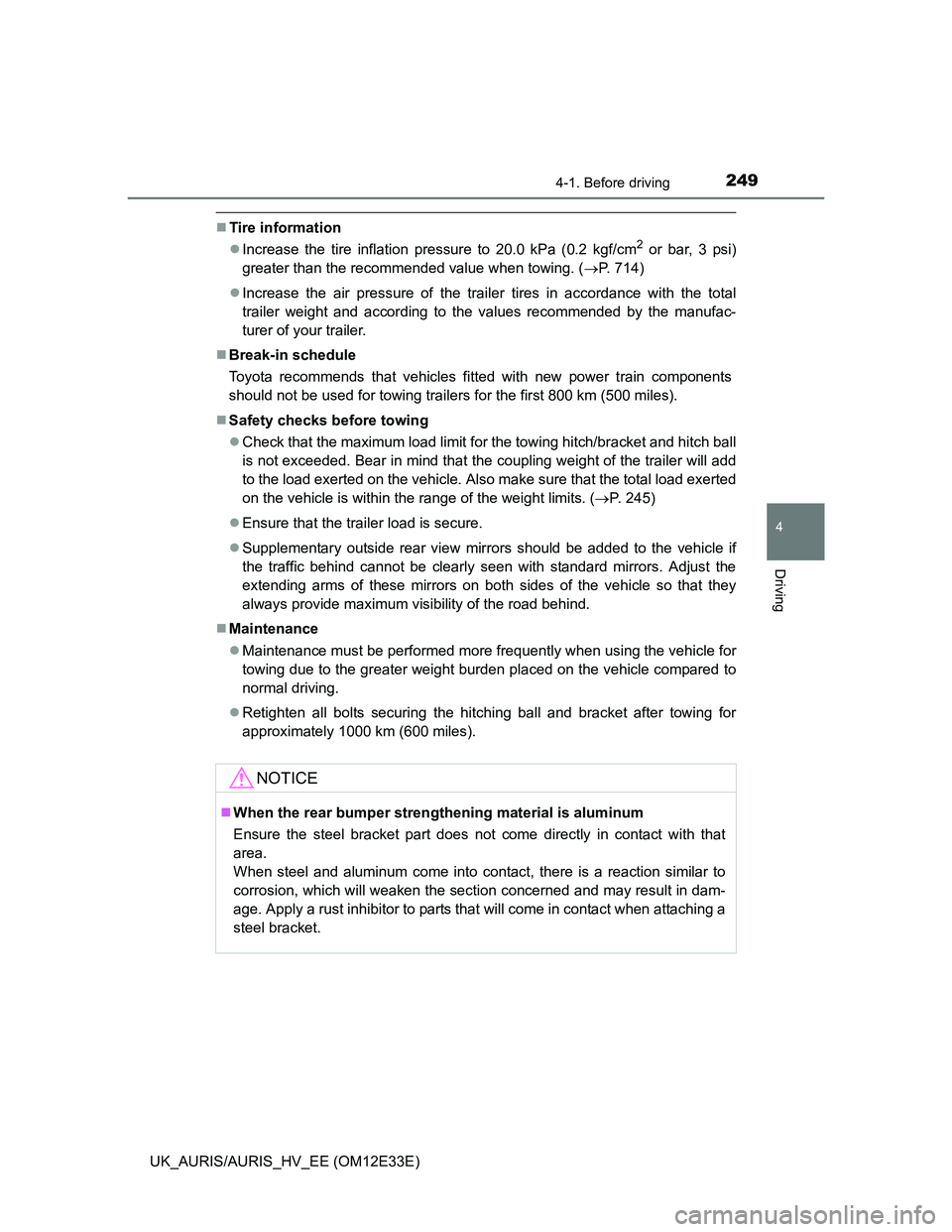Page 246 of 750

2444-1. Before driving
UK_AURIS/AURIS_HV_EE (OM12E33E)
Weight limits
Check the allowable towing capacity, GVM (Gross Vehicle Mass),
MPAC (Maximum Permissible Axle Capacity), and permissible
drawbar load before towing. (P. 696)
Towing hitch/bracket
Toyota recommends the use of the Toyota hitch/bracket for your
vehicle. Other products of a suitable nature and comparable quality
may also be used.
To prevent an accident
The handling of the vehicle will feel different when towing a trailer.
Beware of the 3 most common causes of towing-related accidents:
driver error, excessive speed, and overloading.
Trailer towing (except hybrid model)
The strain of towing a trailer will have a negative impact on the
running performance, handling, fuel consumption and endur-
ance of your vehicle. Use the vehicle features in the correct
manner and operate the vehicle with care for safer driving and
optimal comfort. Damage and/or malfunctions that occur as a
result of towing performed for commercial purposes are not
covered by the Toyota warranty.
Contact any authorized Toyota dealer or repairer, or another duly
qualified and equipped professional for further information
about additional requirements such as towing kits, etc.
Page 247 of 750
2454-1. Before driving
UK_AURIS/AURIS_HV_EE (OM12E33E)
4
Driving
Total trailer weight and permissible drawbar load
Total trailer weight
Weight of the trailer itself plus
the trailer load should be within
the maximum towing capacity.
Exceeding this weight is danger-
ous. (P. 696)
When towing a trailer, use a fric-
tion coupler or friction stabilizer
(sway control device).
Permissible drawbar load
Allocate the trailer load so that
the drawbar load is greater than
25 kg (55.1 lb.) or 4% of the tow-
ing capacity. Do not let the draw-
bar load exceed the indicated
weight. (P. 696)
Important points regarding trailer loads
1
2
Page 248 of 750

2464-1. Before driving
UK_AURIS/AURIS_HV_EE (OM12E33E)
Information tag (manufacturer’s label)
Gross vehicle mass
Maximum permissible rear
axle capacity
Gross vehicle mass
Vehicle category M1 models*
The combined weight of the driver, passengers, luggage, towing
hitch, total curb mass and drawbar load should not exceed the
gross vehicle mass by more than 100 kg (220.5 lb.). Exceeding this
weight is dangerous.
Vehicle category N1 models*
The combined weight of the driver, passengers, cargo, towing hitch,
total curb mass and drawbar load must not exceed the gross vehi-
cle mass. Exceeding this weight is dangerous.
Maximum permissible rear axle capacity
Vehicle category M1 models*
The weight borne by the rear axle should not exceed the maximum
permissible rear axle capacity by 15% or more. Exceeding this
weight is dangerous.
Vehicle category N1 models*
The weight borne by the rear axle should not exceed the maximum
permissible rear axle capacity. Exceeding this weight is dangerous.
The values for towing capacity were derived from testing conducted at
sea level. Take note that engine output and towing capacity will be
reduced at high altitudes.
1
2
Page 251 of 750

2494-1. Before driving
UK_AURIS/AURIS_HV_EE (OM12E33E)
4
Driving
Tire information
Increase the tire inflation pressure to 20.0 kPa (0.2 kgf/cm
2 or bar, 3 psi)
greater than the recommended value when towing. (P. 714)
Increase the air pressure of the trailer tires in accordance with the total
trailer weight and according to the values recommended by the manufac-
turer of your trailer.
Break-in schedule
Toyota recommends that vehicles fitted with new power train components
should not be used for towing trailers for the first 800 km (500 miles).
Safety checks before towing
Check that the maximum load limit for the towing hitch/bracket and hitch ball
is not exceeded. Bear in mind that the coupling weight of the trailer will add
to the load exerted on the vehicle. Also make sure that the total load exerted
on the vehicle is within the range of the weight limits. (P. 245)
Ensure that the trailer load is secure.
Supplementary outside rear view mirrors should be added to the vehicle if
the traffic behind cannot be clearly seen with standard mirrors. Adjust the
extending arms of these mirrors on both sides of the vehicle so that they
always provide maximum visibility of the road behind.
Maintenance
Maintenance must be performed more frequently when using the vehicle for
towing due to the greater weight burden placed on the vehicle compared to
normal driving.
Retighten all bolts securing the hitching ball and bracket after towing for
approximately 1000 km (600 miles).
NOTICE
When the rear bumper strengthening material is aluminum
Ensure the steel bracket part does not come directly in contact with that
area.
When steel and aluminum come into contact, there is a reaction similar to
corrosion, which will weaken the section concerned and may result in dam-
age. Apply a rust inhibitor to parts that will come in contact when attaching a
steel bracket.
Page 699 of 750
6978-1. Specifications
UK_AURIS/AURIS_HV_EE (OM12E33E)
8
Vehicle specifications
*1: Unladen vehicles
*2: Vehicles with 195/65R15 tires
*3: Vehicles with 205/55R16 tires
*4: Vehicles with 215/45R17 tires
*5: Vehicles with 225/45R17 tires
*6: Vehicles with towing package
*7: Vehicles with a Multidrive
*8: Vehicles with a manual transmission
Maximum
permissible axle
capacity
*6
Front
1NR-FE, 1ZR-FAE and 1ND-TV
engines
1020 kg (2249 lb.)
1AD-FTV engine
1080 kg (2381 lb.)
Rear 1010 kg (2227 lb.)
Drawbar load*6
1NR-FE and 1ND-TV engines
55 kg (121 lb.)
1ZR-FAE engine
65 kg (143 lb.)
1AD-FTV engine
72 kg (159 lb.)
Towing capacity*6With brake
1NR-FE and 1ND-TV engines
1000 kg (2205 lb.)
1ZR-FAE engine
1300 kg (2867 lb.)
1AD-FTV engine
1500 kg (3308 lb.)
Without brake 450 kg (992 lb.)
Page 717 of 750
7158-1. Specifications
UK_AURIS/AURIS_HV_EE (OM12E33E)
8
Vehicle specifications
Ty p e C
Compact spare tire
When towing a trailer
Add 20.0 kPa (0.2 kgf/cm
2 or bar, 3 psi) to the recommended tire inflation
pressure and drive at speeds below 100 km/h (62 mph).
Tire size215/45R17 87W
Tire inflation pres-
sure
(Recommended
cold tire inflation
pressure)Vehicle speed
Front wheel
kPa (kgf/cm2
or bar, psi)
Rear wheel
kPa (kgf/cm2
or bar, psi)
More than 160
km/h (100 mph)260 (2.6, 38)260 (2.6, 38)
160 km/h (100
mph) or less230 (2.3, 33)230 (2.3, 33)
Wheel size17 7 J
Wheel nut torque103 N•m (10.5 kgf•m, 76 ft•lbf)
Tire sizeT125/70D17 98M
Tire inflation pressure
(Recommended cold
tire inflation pressure)
420 kPa (4.2 kgf/cm2 or bar, 60 psi)
Wheel size17 4T
Wheel nut torque103 N•m (10.5 kgf•m, 76 ft•lbf)